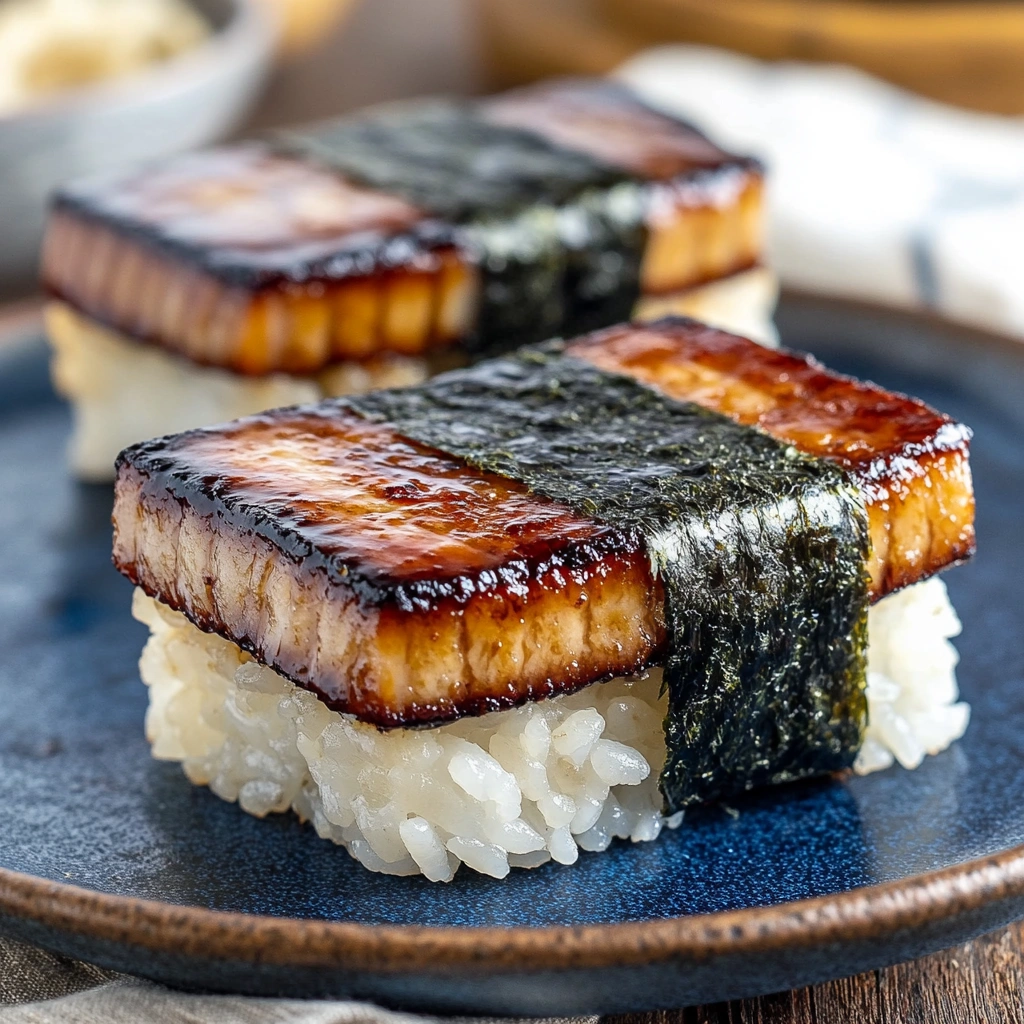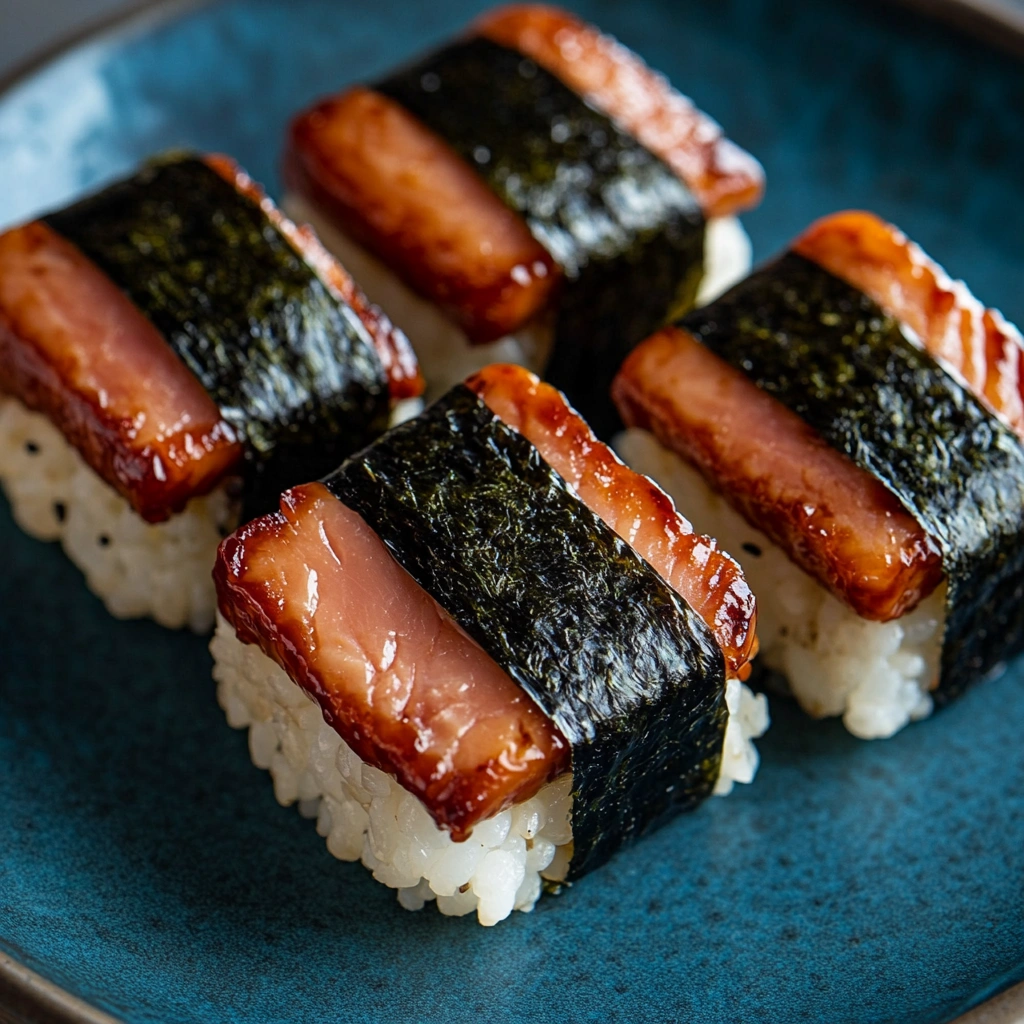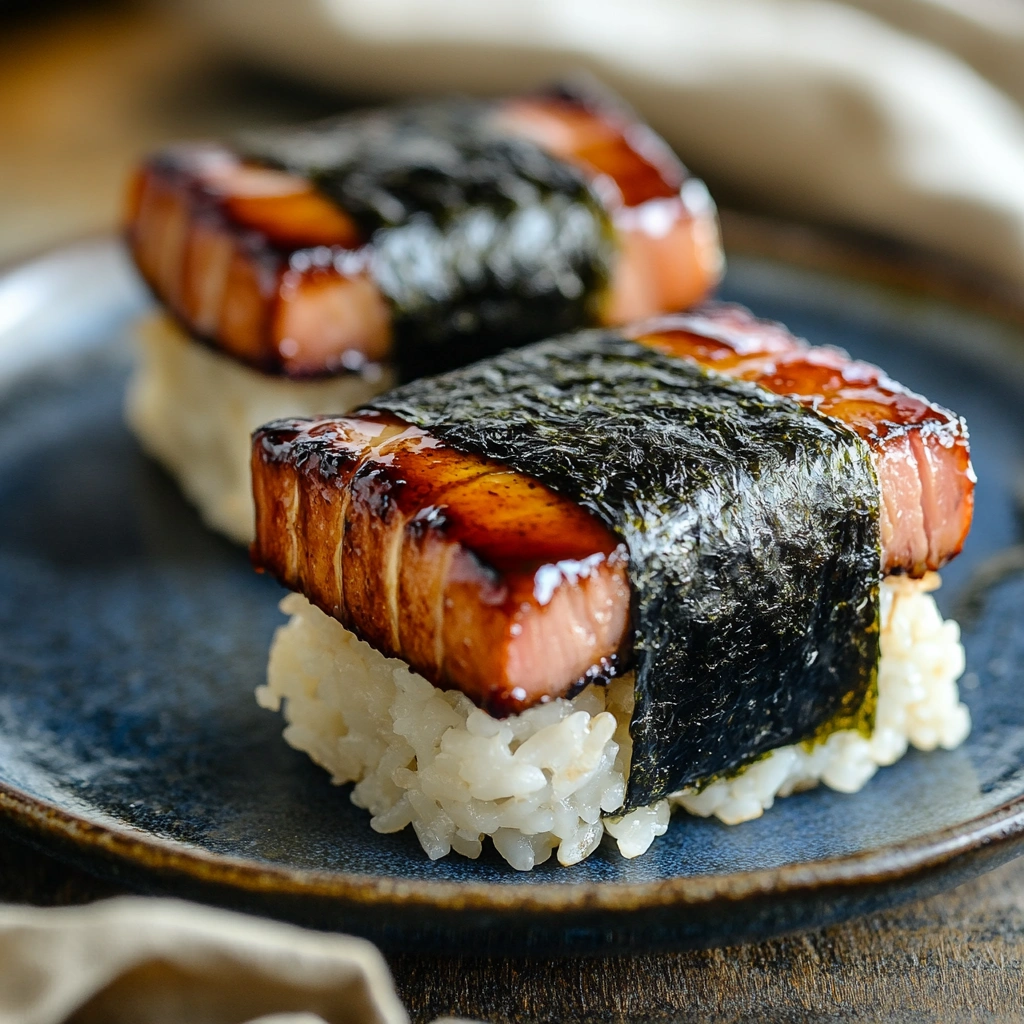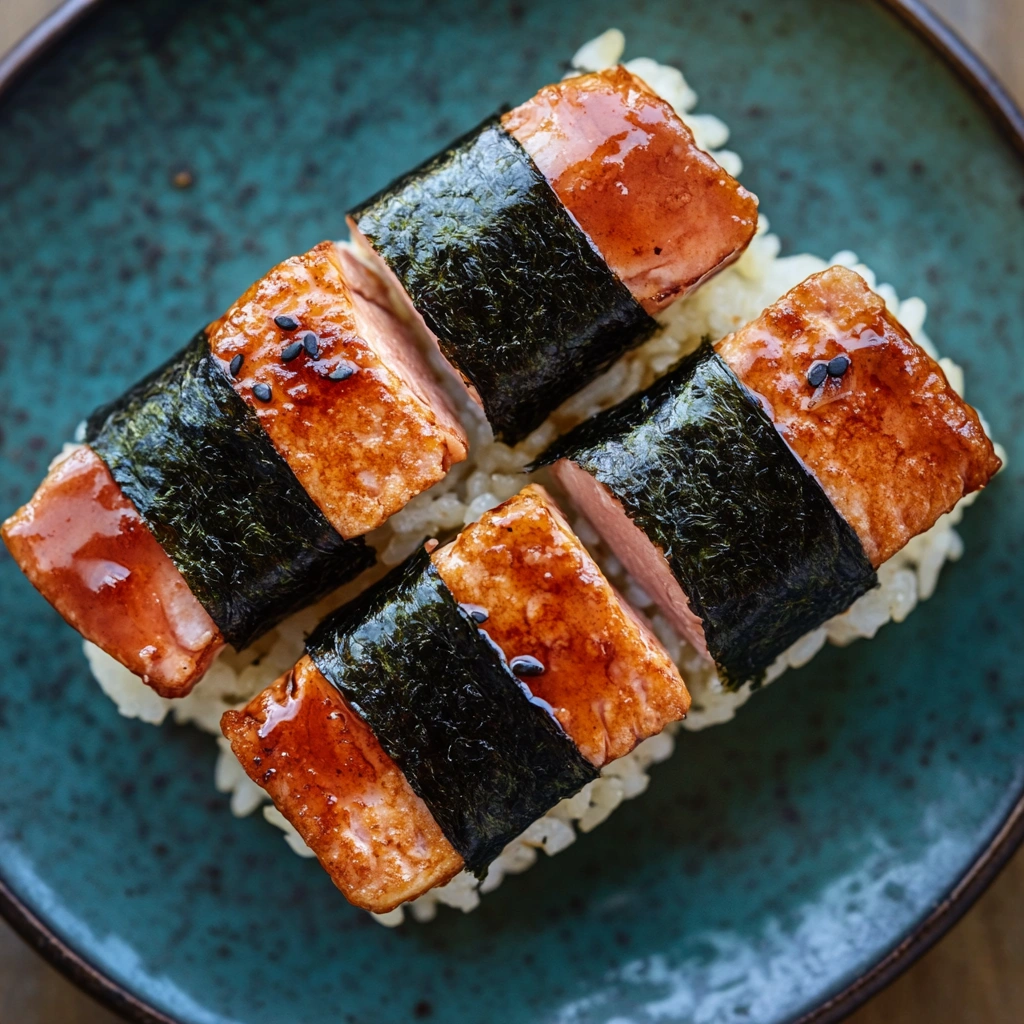Spam Musubi is one of Hawaii’s most iconic snacks, combining a slice of grilled Spam, seasoned rice, and a seaweed wrap into a portable, flavorful bite. Rooted in Japanese and Hawaiian culinary traditions, this dish reflects Hawaii’s diverse food culture, blending influences from onigiri (Japanese rice balls) and the popularity of Spam introduced during World War II.
Despite its simple ingredients, achieving the perfect balance of flavors and textures requires careful technique. This article covers the history, essential components, and secrets to preparing authentic sushi rice—a crucial element in making this dish just right.
For more on the ingredients and variations, visit Ingredients in Spam Musubi.
Introduction: What Makes This Snack So Popular?
What It’s Made Of
This handheld treat consists of:
- Pan-seared Spam with a lightly caramelized glaze.
- A compact block of seasoned rice for structure and balance.
- A nori seaweed wrap to hold everything together.
The combination creates a savory, slightly sweet, and umami-rich flavor that is easy to enjoy anywhere.
Why It’s a Hawaiian Staple
This snack has become a go-to meal across Hawaii, available in:
- Convenience stores such as 7-Eleven, where it’s a best-seller.
- Local restaurants offering unique versions with different toppings.
- Homemade variations, often packed for school lunches or beach trips.
A Blend of Japanese and Hawaiian Traditions
The origins of this dish are closely tied to Japanese onigiri, a rice ball wrapped in seaweed, which was adapted in Hawaii to include Spam as the protein of choice. The result is a dish that reflects Hawaii’s multicultural identity, blending flavors from Japan, Hawaii, and American military influence.
For a deeper dive into this fusion of flavors, check out Spam Musubi Recipe.
The History Behind This Hawaiian Classic
How Spam Became a Hawaiian Pantry Staple
During World War II, fresh meat was scarce, and U.S. military bases stocked canned Spam as a reliable protein source. Hawaiians quickly adopted it into their cuisine, incorporating it into:
- Breakfast plates with eggs and rice.
- Loco Moco (rice, hamburger patty, egg, and gravy).
- Fried rice dishes and stews.
Japanese Influence on the Dish
When Japanese immigrants brought onigiri to Hawaii, the concept of rice wrapped in seaweed was already familiar. However, local adaptations included:
- Grilled Spam replacing fish or pickled plums as the filling.
- Soy sauce and sugar marinades for added depth of flavor.
- A rectangular shape, molded for a more structured bite.
How It Became a Beloved Hawaiian Snack
Over time, this dish became a mainstay in Hawaiian cuisine because:
- It’s affordable and easy to make.
- It offers a perfect balance of salty, sweet, and umami flavors.
- It’s portable, making it ideal for busy lifestyles.
For another dish that highlights Japanese-Hawaiian fusion, visit Sinigang Recipe.
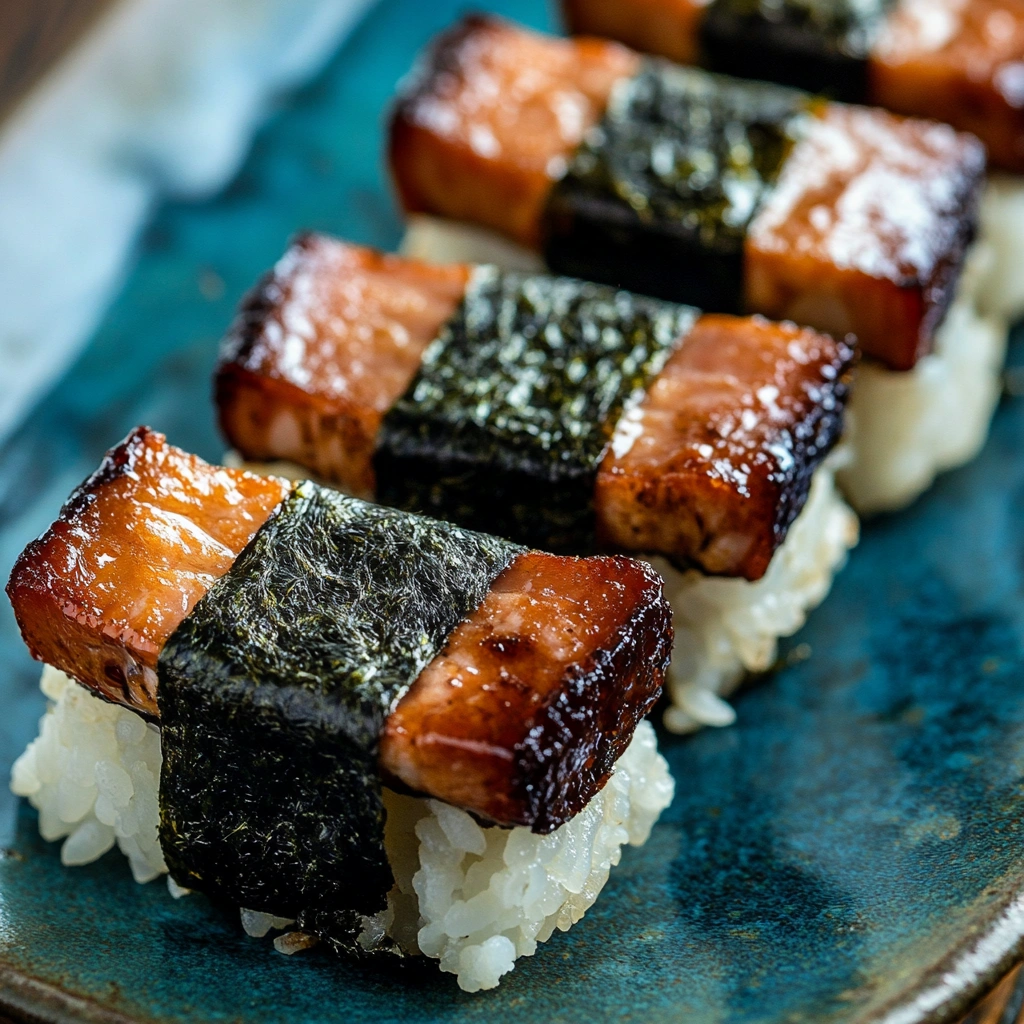
Essential Ingredients for Authentic Flavor
Choosing the Right Spam
The protein is the star of the dish, and different types of Spam can be used:
- Classic Spam: The original, offering a rich, salty taste.
- Lite Spam: A lower-fat option with a milder flavor.
- Flavored Spam: Variants like Teriyaki or Hickory Smoked add extra depth.
For the most authentic taste, classic Spam is the preferred choice, pan-fried until golden brown with crispy edges.
The Importance of Sushi Rice
Regular long-grain rice won’t hold its shape, which is why short-grain sushi rice is essential. It provides:
- The perfect sticky texture for holding the structure.
- Better absorption of seasonings, enhancing the overall taste.
Nori: The Finishing Touch
A thin strip of seaweed is wrapped around the rice and Spam to keep everything intact. Options include:
- Traditional nori: Unsalted and crisp, offering a mild umami taste.
- Seasoned nori: Infused with sesame oil, soy sauce, or wasabi for added complexity.
For a detailed breakdown of the essential components, visit Ingredients in Spam Musubi.
A Simple Yet Flavorful Marinade
Many versions glaze the Spam before assembling the final dish. The classic sweet-savory marinade includes:
- Soy sauce for umami richness.
- Oyster sauce for depth.
- Sugar to caramelize the Spam while cooking.
This quick glaze enhances the flavor profile, balancing the saltiness of the Spam with a touch of sweetness.
The Secret to Perfect Sushi Rice
Why Regular Rice Won’t Work
Using standard long-grain rice leads to a crumbly texture, making the dish difficult to eat. Instead, short-grain sushi rice is used because it:
- Has the right amount of stickiness, holding its shape well.
- Absorbs seasonings evenly, complementing the Spam’s bold flavors.
Best Cooking Methods
There are two effective ways to prepare sushi rice:
- Stovetop Method:
- Rinse the rice thoroughly until the water runs clear.
- Add a 1:1 water-to-rice ratio and bring to a boil.
- Reduce heat, cover, and let simmer for 15 minutes.
- Let the rice rest for 10 minutes before use.
- Instant Pot Method:
- Use a 1:1 water-to-rice ratio.
- Pressure cook on high for 5 minutes, then let it naturally release for 10 minutes.
Seasoning and Shaping the Rice
After cooking:
- Mix rice vinegar, sugar, and salt, then gently fold it into the rice.
- Use a Musubi mold or hand-shape the rice into compact rectangles.
- Ensure the rice holds together, but don’t overpack it, keeping a light texture.
For another dish where rice texture is crucial, check out Easy Yellow Rice Recipe.
Step-by-Step Guide to Making Spam Musubi
Preparing the Spam: Slicing, Marinating, and Frying
The key to great Spam Musubi starts with properly preparing the Spam.
How to Slice Spam for Musubi
- Open a can of Spam and remove it from the container.
- Slice it into ¼-inch thick pieces for the perfect balance of crispiness and texture.
- A single can typically yields 7-8 slices, depending on thickness.
Marinating for Extra Flavor
While some prefer plain seared Spam, marinating enhances its taste. A simple sweet-savory glaze includes:
- 2 tablespoons soy sauce
- 1 tablespoon oyster sauce (optional for depth)
- 1 tablespoon sugar
Marinate the Spam slices for 5-10 minutes before cooking.
Pan-Frying for the Perfect Texture
- Heat a nonstick pan over medium heat (no oil needed since Spam contains fat).
- Cook Spam slices for 2-3 minutes per side until golden brown and slightly crispy.
- If marinated, allow the sauce to caramelize for a rich, umami glaze.
Using a Musubi Mold vs. Making It by Hand
A Musubi mold makes shaping the rice easier, but it can also be done by hand.
Using a Musubi Mold
- Place the mold on a flat surface.
- Add a layer of rice (about ½ cup), pressing it gently to create an even base.
- Lay a Spam slice on top.
- Press firmly using the mold’s press tool, then remove the mold.
Making It by Hand
- Wet your hands with water or rice vinegar to prevent sticking.
- Shape about ½ cup of rice into a compact rectangular block.
- Place a Spam slice on top and press down gently.
Wrapping Techniques for a Clean and Secure Musubi
- Cut nori into strips (about 2 inches wide).
- Lay a strip of nori flat and place the assembled Spam Musubi in the center.
- Wrap the nori around the rice and Spam, sealing the ends with a small dab of water.
- For a tight seal, place the wrapped Musubi seam-side down for a minute before serving.
For a deeper dive into Spam Musubi ingredients, visit Ingredients in Spam Musubi.

